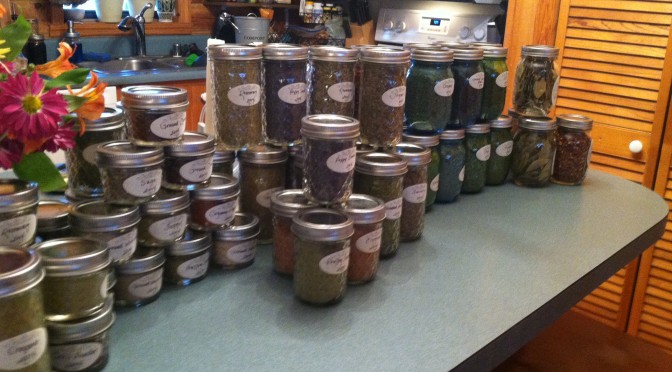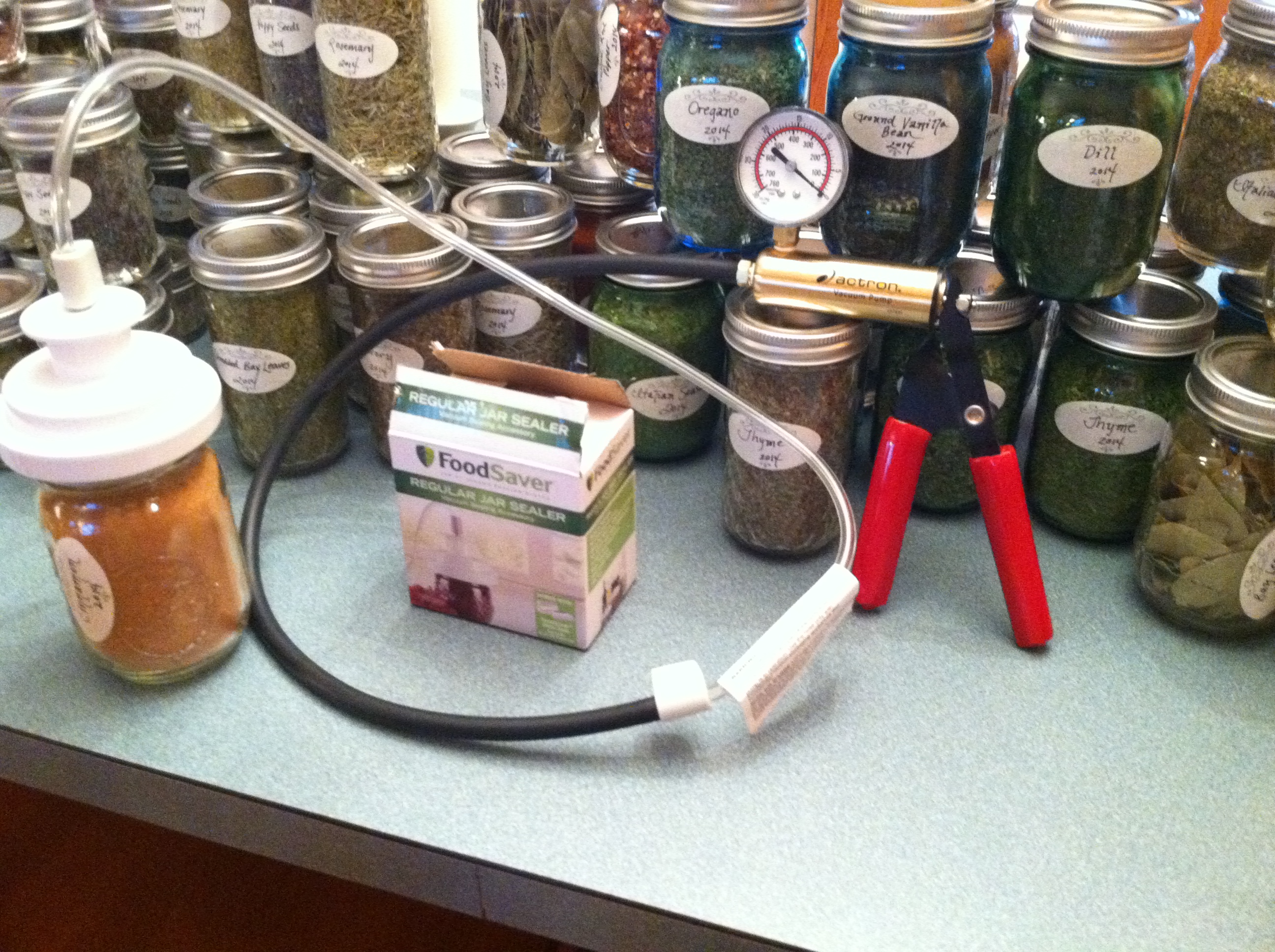From Mrs. Cog's Corner
In case you haven't heard, I love to can. Cog says I am a compulsive canner, but I swear I can stop any time.
I use this simple "dry canning" method to vacuum seal some of our dry goods. It works for dehydrated food, brown sugar and even spices. We get fresh spices in bulk as we are fortunate enough to have a family member work for a large spice company. Although it can be done with an electric Food Saver device, I have opted to get a hand pump (as shown below).
Here is a quick video that shows how easy it is to vacuum seal your jars.
As you may know, successfully storing food, especially dry goods, is a matter of regulating the moisture, oxygen, temperature and light. Storing things such as spices in a cool dark place after being vacuum sealed can greatly extend their shelf life. The longest I have yet tested is 5 year old Cayenne Pepper which still packed a punch.
With respect to spices, one of the nice things about packaging them this way is that I can choose the size of jars. As prices continue to rise rapidly for flavors I have always taken for granted, this is a wonderful way to share and give gifts. If you are not growing your own spices to dry and can, many are available at bulk goods stores such as Sam's Club, BJ's or Costco for a fraction of the regular grocery store prices.
Please note: I am not referring to the method of "dry canning" that involves heating in an oven.
It would be wonderful to hear from any of you below with experiences in this arena.
Read More:
Many people tell me they are curious about making Salad in a Jar (vacuum-packed chopped lettuce) but don’t have or can’t afford a vacuum-pack machine. A few months ago, I was elated to learn it can be done with a portable vacuum-pack machine costing around $20. But now I’ve discovered something even cheaper, thanks to my blogger friend Vicki. http://www.salad-in-a-jar.com/family-recipes/how-to-vacuum-pack-salad-in-a-jar-for-less-than-6-plus-a-video
Other methods: Dry Pack Canning is the process used to store foods that have less than 10% moisture and are low in oil content. When properly done, these items will last a long time – maybe even 30 years under certain conditions. http://preparednessmama.com/dry-pack-canning/
I use my FoodSaver to dry can/vacuum pack the herbs and spices. (I know dry canning implies adding heat but since there should be no moisture and it’s not enough heat to kill anything essentially it does the same thing. Although I would argue vacuum packing is actually better because heat will help the contents of the jar deteriorate.) In this picture I’m vacuum packing parsley. http://arewecrazyorwhat.net/food-storage-storing-herbs-and-spices-for-long-term-storage/
My friends and I get together for a repackaging party. We use my Vac sealer to the package the herbs and spices into small 1 to 2 oz. packets. The packets are labeled and placed into clean #10 cans with a lid. To really insure protection, you can remove the air from your canning jars by using your Vac sealer again. You can also put your packets into clean mismatched jars that has a tight lid. http://canningandpreserving.net/preserving-bulk-dried-herbs-spices-and-baking-ingredients-long-term-food-storage/html


Hello, Mrs. C – and Other Canning Aficionados :
I, too, am a fervent proponent of the FoodSaver system. I’m now on my third iteration of that product, having first been introduced to it back in the late 90’s.
We buy organic grains, beans, seeds and other staples in bulk and then re-package them into 3 – 5lb. units using the FoodSaver bags and vacuum-sealing system. These smaller bags are then labeled, dated and re-stored in a dark, dry food-grade bin from which we take only what we need as we go, which keeps the majority of our purchases fresh as long as possible. Most dried goods packed this way last WAY longer than one would imagine and still taste good!
I also do traditional canning of fruits, pickles, and certain vegetables as well as use two old but still totally functional dehydrators to dry herbs and fruit and veggies for winter use. These dried items are then vacuum-bagged, as are nuts that come from our orchard. These keep beautifully, again for a much longer period than one would guess.
We also dry herbs the old-fashioned way, strung in bunches over wires just below the floor joists in our cellar, which is cool, dry and very dark – perfect for optimally dried natural herbs. When dry, these are then bagged and sealed. We grow both culinary and medicinal herbs and teas, and all do well via this method.
We also make a variety of meat jerkys, including deer, beef, turkey, and other wild game is preserved via the making of traditional ‘biltong’ from South Africa which was used by the Boers during their Voertrekker days in the early 1800’s for meat preservation on the trail. This is a particularly yummy way to preserve meat for a VERY long time. I am exploring the use of a Weber smoker/tower, which I have yet to tackle, but it’s next on my list of food skills to master.
All of these methods make for optimal use of healthy foods and provide the means to create very tasty snacks and meals without using processed and pre-packaged commercial foods. I’m willing to share processes and recipes and insights with anyone here who would like to try this. The only thing I have not tackled is pressure canning, so I will leave that arena in Mrs. Cog’s capable hands!
:) LionLady
@LionLady
Sounds wonderful. I know who to see when I get to the jerky portion of the program. Thanks! ;-)